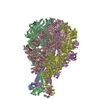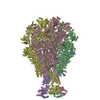+ Open data
Open data
- Basic information
Basic information
| Entry | Database: EMDB / ID: EMD-10035 | |||||||||
|---|---|---|---|---|---|---|---|---|---|---|
| Title | Cryo-EM structure of Morganella morganii TcdA4 | |||||||||
 Map data Map data | Cryo-EM density map of Morganella morganii TcdA4 | |||||||||
 Sample Sample |
| |||||||||
| Function / homology |  Function and homology information Function and homology information | |||||||||
| Biological species |   Morganella morganii subsp. morganii (bacteria) Morganella morganii subsp. morganii (bacteria) | |||||||||
| Method |  single particle reconstruction / single particle reconstruction /  cryo EM / Resolution: 3.27 Å cryo EM / Resolution: 3.27 Å | |||||||||
 Authors Authors | Roderer D / Leidreiter F / Gatsogiannis C / Meusch D / Benz R / Raunser S | |||||||||
| Funding support |  Germany, 1 items Germany, 1 items
| |||||||||
 Citation Citation |  Journal: Sci Adv / Year: 2019 Journal: Sci Adv / Year: 2019Title: Common architecture of Tc toxins from human and insect pathogenic bacteria. Authors: F Leidreiter / D Roderer / D Meusch / C Gatsogiannis / R Benz / S Raunser /  Abstract: Tc toxins use a syringe-like mechanism to penetrate the membrane and translocate toxic enzymes into the host cytosol. They are composed of three components: TcA, TcB, and TcC. Low-resolution ...Tc toxins use a syringe-like mechanism to penetrate the membrane and translocate toxic enzymes into the host cytosol. They are composed of three components: TcA, TcB, and TcC. Low-resolution structures of TcAs from different bacteria suggest a considerable difference in their architecture and possibly in their mechanism of action. Here, we present high-resolution structures of five TcAs from insect and human pathogens, which show a similar overall composition and domain organization. Essential structural features, including a trefoil protein knot, are present in all TcAs, suggesting a common mechanism of action. All TcAs form functional pores and can be combined with TcB-TcC subunits from other species to form active chimeric holotoxins. We identified a conserved ionic pair that stabilizes the shell, likely operating as a strong latch that only springs open after destabilization of other regions. Our results provide new insights into the architecture and mechanism of the Tc toxin family. | |||||||||
| History |
|
- Structure visualization
Structure visualization
| Movie |
 Movie viewer Movie viewer |
|---|---|
| Structure viewer | EM map:  SurfView SurfView Molmil Molmil Jmol/JSmol Jmol/JSmol |
| Supplemental images |
- Downloads & links
Downloads & links
-EMDB archive
| Map data |  emd_10035.map.gz emd_10035.map.gz | 22 MB |  EMDB map data format EMDB map data format | |
|---|---|---|---|---|
| Header (meta data) |  emd-10035-v30.xml emd-10035-v30.xml emd-10035.xml emd-10035.xml | 12.6 KB 12.6 KB | Display Display |  EMDB header EMDB header |
| Images |  emd_10035.png emd_10035.png | 74.8 KB | ||
| Archive directory |  http://ftp.pdbj.org/pub/emdb/structures/EMD-10035 http://ftp.pdbj.org/pub/emdb/structures/EMD-10035 ftp://ftp.pdbj.org/pub/emdb/structures/EMD-10035 ftp://ftp.pdbj.org/pub/emdb/structures/EMD-10035 | HTTPS FTP |
-Related structure data
| Related structure data |  6rw9MC  6rw6C  6rw8C  6rwaC  6rwbC M: atomic model generated by this map C: citing same article ( |
|---|---|
| Similar structure data |
- Links
Links
| EMDB pages |  EMDB (EBI/PDBe) / EMDB (EBI/PDBe) /  EMDataResource EMDataResource |
|---|
- Map
Map
| File |  Download / File: emd_10035.map.gz / Format: CCP4 / Size: 244.1 MB / Type: IMAGE STORED AS FLOATING POINT NUMBER (4 BYTES) Download / File: emd_10035.map.gz / Format: CCP4 / Size: 244.1 MB / Type: IMAGE STORED AS FLOATING POINT NUMBER (4 BYTES) | ||||||||||||||||||||||||||||||||||||||||||||||||||||||||||||
|---|---|---|---|---|---|---|---|---|---|---|---|---|---|---|---|---|---|---|---|---|---|---|---|---|---|---|---|---|---|---|---|---|---|---|---|---|---|---|---|---|---|---|---|---|---|---|---|---|---|---|---|---|---|---|---|---|---|---|---|---|---|
| Annotation | Cryo-EM density map of Morganella morganii TcdA4 | ||||||||||||||||||||||||||||||||||||||||||||||||||||||||||||
| Voxel size | X=Y=Z: 1.14 Å | ||||||||||||||||||||||||||||||||||||||||||||||||||||||||||||
| Density |
| ||||||||||||||||||||||||||||||||||||||||||||||||||||||||||||
| Symmetry | Space group: 1 | ||||||||||||||||||||||||||||||||||||||||||||||||||||||||||||
| Details | EMDB XML:
CCP4 map header:
| ||||||||||||||||||||||||||||||||||||||||||||||||||||||||||||
-Supplemental data
- Sample components
Sample components
-Entire : M. morganii TcdA4 pentamer
| Entire | Name: M. morganii TcdA4 pentamer |
|---|---|
| Components |
|
-Supramolecule #1: M. morganii TcdA4 pentamer
| Supramolecule | Name: M. morganii TcdA4 pentamer / type: complex / ID: 1 / Parent: 0 / Macromolecule list: all |
|---|---|
| Source (natural) | Organism:   Morganella morganii subsp. morganii (bacteria) Morganella morganii subsp. morganii (bacteria) |
| Recombinant expression | Organism:   Escherichia coli (E. coli) Escherichia coli (E. coli) |
| Molecular weight | Theoretical: 1.4 MDa |
-Macromolecule #1: Insecticidal toxin protein TcdA4
| Macromolecule | Name: Insecticidal toxin protein TcdA4 / type: protein_or_peptide / ID: 1 / Number of copies: 5 / Enantiomer: LEVO |
|---|---|
| Source (natural) | Organism:   Morganella morganii subsp. morganii (bacteria) Morganella morganii subsp. morganii (bacteria) |
| Molecular weight | Theoretical: 275.658312 KDa |
| Recombinant expression | Organism:   Escherichia coli (E. coli) Escherichia coli (E. coli) |
| Sequence | String: MDQITRILEK LNQQRSGETT VTLADFMPMS LAEIRSQNTG RLSREEAQLL HRAAQKEKQN NILYTARMLT RANPLLKKEM NTARYYGAT PYGYDDIIPP RAEKFVAPGA VSSMFSPAGY LTELYREARG LHPKDSDRNL DKRRQDLAKL VLSQDNLDNE I SALSLANE ...String: MDQITRILEK LNQQRSGETT VTLADFMPMS LAEIRSQNTG RLSREEAQLL HRAAQKEKQN NILYTARMLT RANPLLKKEM NTARYYGAT PYGYDDIIPP RAEKFVAPGA VSSMFSPAGY LTELYREARG LHPKDSDRNL DKRRQDLAKL VLSQDNLDNE I SALSLANE QLETALMAQT GKTDKNKYYE TLATSRRSGV TPYNAPFEGI HNALAQRNFV LPDNILSNPA KFAILAAYDA GI SPKLYNI LTEDTESLTG SDLENSLKRN FPKVKIKDLM TLDALANYYE LPADDIQALI AAEITGRLPT PDVYNDDNKL VIP AINTGG KITFSELAKT QSDEKQADYI DLIPQGGNQF LVNFSVKKTK KDATHFSIGY NKSFNNLADK NGFVPLAGEH YSIP VTLDA KILEKKTKIG ITRKKPEPAS DENHYTSATF TIHPNAEPGI WLLRLNKTLR LAKVSGMTPH ETQHALIHVR NDSSE YELR RFTETLLYRK RYGIDTETAL MLCNAGISRI SYDGQLSHFD RLFNNPPLNG VTYTLGGDDI LMEPDAGDPR REVLKR AFR VDNTGLWQLL VITNRENKSK TIENKTEKLR GLLFVRLLAD VHNLTVAQLD ALLQISPYNS MNVYALDGKT RQKMLSF LS RITQWLNTQN ITVEQLMLLL DKISPAAPTK EMQVLLDLLR NGGIDKTNTK TLYTTMAPVI TAAMQLDITE SGEALLRW L DNNHPAGILT TSEARKLIIK KGQTAGDKEK LAAWCQALAQ RVLVIRTFTL SNAELQTLSQ GAPAGTITEL YNISDFHNL INRCGEQAGT VLDALQSGTL TVKILAQALN LSEEVITQAL TLAGQKPELT TWAQLAVLPP RLDLADTLHI TPKDITTLLT VSENVRPFY TDLSALAGLL QAGLNEQQTK QLQNQSEPRR NEALSGEYRS LVMNNPVADR DDIWRNLLVD GKVSAEITTT L LADAIAGI QLYINRTIAG DEPGADSDAL ERQFFKDWDA CNKRYSTWAG VSQLVYYPEN FVDPTLRTGQ TGMMNTMLEQ LS QSELNKD TLENGFRQYL TAFEQVADLK VVSGYHDTVN INQGNTWFIG TSQTEPKKYY WRKADHSKCQ NGRFAANAWS DWK EITCAV NPYGDMVRPV IFHSRLYLLW IEKQVQKDNT GKDTASFTLK LTHVKYDGSW ASPFSYDITE KNISGWKKTG LYCA ASQED NSLLIAWYQI EKETQPNSFG LHIQPDMSCK KEPNIAGILA TVTHQLDTET TVRVNTLLNR ISSFEFTLEK QEGNK EIDL VISHGDYTVK TENSISALIL NPTAYINITP YKLFSDIPDF YREKYITHLN SHSGTVYAPE SKKMEPANNA ISDKVN ACA VYTYNNKPPK KHISLSIGKN YPLITPLELV GRKLESFFIK HKETSALYYT YGDATDDRLT LEEDKYTIST GEKKLGT LS LGKMIAQVKT ISSDDISMEI ELNSTKFETI TGSDVGLRPP LYPTVSRETL AFPFGKLSIT IPAGADINNL DCTIKVRF K NTDVLAATTT YKLVIKKTDP VQKVISLYTT PDGAQYMEWD GYRTRLNTLF TRQLIERANN GIDAILSPET QYLPEPKPG QGTYVTLILK PYDKNTHGTN RAFTIYYSND ATGSGKFPVY SGSLSVTDNT EVKLFIPLIK PGKNAVSQSA GAQQDTLYLN ATYQKEATK QILLFRTDNN PEGWTLDKSV NNGTFAGLAE NGVTGLLQSG EPMDFSGANA LYFWELFYYT PMMVATRLLQ E QNFTEANR WLSYIWQPAA SGAGDWRVRP LKEDTSWNAD PLDSVDPDAV AQNDPMHYKV STLMKLLDLL IARGDKAYRM QE RDTLNEA KMWYMQALGL LGDKPVSIFS NGWENPSLSN AADKTQAKQF HDEISRIRSG GLLPDVRTAN TLTGLFRPQQ NEK LLGYWQ MLEMRLFNLR NNLSIDGQPL SLPVFAAPAD PAALLSAAAA ASGGSKPLPS ADIPAMRFPQ ALDSARSLTG QLMQ FGSTL LGLIERRDAE AMSELLQNQA GELMLSSLRM QEQALTELDA EKKILEQSRA GAQSRVDSYR ALYDENVSAE EKRTM DLYL SSAILSTSIG VLDMAAAAAD MAPNIFGVAV GGSRWGGIPK AIGAGMSLAA SATKITADNI SQSEAWRRRR QEWEIQ KNN AESEIRQIDA QLEALAVRRT ATEMQREHME IQQAQTQAQL EFLQRKFSNK ALYSWLRGRL ASIYYRFYDL TAARCMM AE KAYAWQTNDT ATRYIKSGAW QSNNAGLMAG ESLLLNLAEM EQAWLKRDSR SLEVTRTVSL AAVYRTDNVT LAEGIADL L KGNGSGNIPA STGLSMTADN QLHAAFNLKA LNIKDDYPEA LGTTRRIKQI SVTLPALVEP YQDMRAIFRY GGNSLPAGC KAIALSHGIN DDGLFRLDFN DGRWLPFEGI PVDDDNSLTL SFPDATGEKQ KPLLLSLTDI IIHIRYTIC |
-Experimental details
-Structure determination
| Method |  cryo EM cryo EM |
|---|---|
 Processing Processing |  single particle reconstruction single particle reconstruction |
| Aggregation state | particle |
- Sample preparation
Sample preparation
| Buffer | pH: 8 |
|---|---|
| Vitrification | Cryogen name: ETHANE |
- Electron microscopy
Electron microscopy
| Microscope | FEI TITAN KRIOS |
|---|---|
| Electron beam | Acceleration voltage: 300 kV / Electron source:  FIELD EMISSION GUN FIELD EMISSION GUN |
| Electron optics | Illumination mode: SPOT SCAN / Imaging mode: BRIGHT FIELD Bright-field microscopy Bright-field microscopy |
| Image recording | Film or detector model: FEI FALCON II (4k x 4k) / Average exposure time: 1.5 sec. / Average electron dose: 60.0 e/Å2 |
| Experimental equipment |  Model: Titan Krios / Image courtesy: FEI Company |
- Image processing
Image processing
| Initial angle assignment | Type: OTHER / Software - Name: SPHIRE |
|---|---|
| Final angle assignment | Type: OTHER / Software - Name: SPHIRE |
| Final reconstruction | Applied symmetry - Point group: C5 (5 fold cyclic ) / Resolution.type: BY AUTHOR / Resolution: 3.27 Å / Resolution method: FSC 0.143 CUT-OFF / Software - Name: SPHIRE / Number images used: 247513 ) / Resolution.type: BY AUTHOR / Resolution: 3.27 Å / Resolution method: FSC 0.143 CUT-OFF / Software - Name: SPHIRE / Number images used: 247513 |
 Movie
Movie Controller
Controller
















